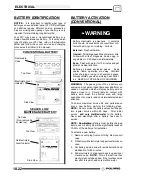
ELECTRICAL
10.28
LOW MAINTENANCE
BATTERY LOAD TEST
CAUTION:
To prevent shock or component
damage, remove spark plug high tension leads
and connect securely to engine ground before
proceeding.
NOTE:
This test can only be performed on machines
with electric starters. This test cannot be performed
with an engine or starting system that is not working
properly.
A battery may indicate a full charge condition in the OCV
test and the specific gravity test, but still may not have
the storage capacity necessary to properly function in
the electrical system. For this reason, a battery capacity
or load test should be conducted whenever poor battery
performance is encountered. To perform this test, hook
a multitester to the battery in the same manner as was
done in the OCV test. The reading should be 12.6 volts
or greater. Engage the starter and observe the battery
voltage while cranking the engine. Continue the test for
15 seconds. During cranking the observed voltage
should not drop below 9.5 volts. If the beginning voltage
is 12.6 volts or higher and the cranking voltage drops
below 9.5 volts during the test, replace the battery.
LOW MAINTENANCE
BATTERY OFF--SEASON
STORAGE
To prevent battery damage during extended periods
of non-use, the following basic battery maintenance
items must be performed:
G
Remove the battery from the
machine and wash the case and
battery tray with a mild solution of
baking soda and water. Rinse with
lots of fresh water after cleaning.
G
Using a wire brush or knife, remove
any corrosion from the cables and
terminals.
G
Make sure that the electrolyte is at
the proper level.
G
Charge at a rate no greater than 1/10
of the battery’s amp/hr capacity until
the electrolyte’s specific gravity
reaches 1.270 or greater.
G
Store the battery either in the
machine
with
the
cables
disconnected, or store in a cool
place.
NOTE:
Stored batteries lose their charge at the rate
of 1% per day. Recharge to full capacity every 30 to
60 days during a non-use period. If the battery is
stored during the winter months, electrolyte will freeze
at higher temperatures as the battery discharges.
The chart below indicates freezing points by specific
gravity.
Electrolyte Freezing Points
Specific Gravity
of Electrolyte
Freezing
Point
1.265
-75
°
F
1.225
-35
°
F
1.200
-17
°
F
1.150
+5
°
F
1.100
+18
°
F
1.050
+27
°
F
LOW MAINTENANCE
BATTERY CHARGING
PROCEDURE
1. Remove the battery from the ATV to prevent
damage from leaking or spilled acid during
charging.
2. Charge the battery with a variable rate charging
output. Charge as needed to raise the specific
gravity to 1.270 or greater.
3. Install battery in vehicle with positive terminal
toward the front. Coat threads of battery bolt with
a corrosion resistant Nyogel
t
Grease (
PN
2871329
).
4. Route cables so they are tucked away in front and
behind battery.
5. Connect battery cables.
WARNING
To avoid the possibility of sparks and explosion,
connect positive (red) cable first and negative (black)
cable last.
6. After connecting the battery cables, install the
cover on the battery and attach the hold down
strap.
Содержание Sportsman 800 Efi 2005
Страница 116: ...ENGINE 3 62 NOTES ...
Страница 136: ...FUEL SYSTEM FUEL INJECTION 4 20 NOTES ...
Страница 186: ...CLUTCH 6 30 NOTES ...
Страница 256: ...BRAKES 9 24 NOTES ...
Страница 292: ...ELECTRICAL 10 36 BASIC WINCH WIRING 2005 ATV MODELS 2005 ATV WINCH WIRING DIAGRAM ...
Страница 300: ...ELECTRICAL 10 44 NOTES ...
Страница 301: ...ELECTRICAL 10 39 WIRING DIAGRAM 2005 SPORTSMAN 700 800 EFI Stator ...
Страница 302: ...ELECTRICAL 10 40 WIRING DIAGRAM 2005 SPORTSMAN 700 800 EFI ...















































